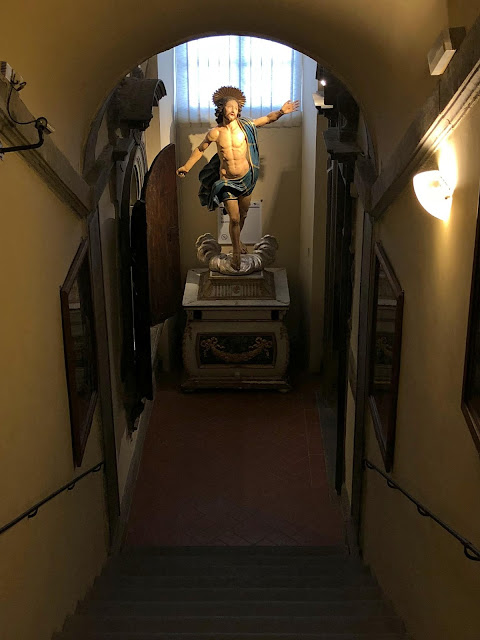After about 45 minutes we arrived in the foothills below the Basilica di San Francesco d'Assisi - one of the most important Christian pilgrimage sites in all Italy and a UNESCO World Heritage Site. Along with Saint Catherine of Siena, Saint Francis was designated as the Patron Saint of Italy and is one of the most venerated religious figures in history. The Basilica is built on a site, the "Hill of Hell" where, formerly, criminals were put to death, but now it's called the "Hill of Paradise".
After parking in the underground Parcheggio Saba Gionanni Paolo II lot we entered the city through the Porta San Francesco and made our way up the Via Frate Elia.
Almost immediately, we found ourselves in the massive courtyard that lead to the Basilica of Saint Francis.
We only had about an hour before the Basilica closed so we made our way quickly inside and down into the Lower Church and the crypt where Saint Francis' remains are buried in a stone coffin with iron ties enshrined above an open alter. An urn holding the remains of a his most faithful friend, a Roman woman of nobility referred to as Brother Jacoba, marks the entrance to the crypt. Francis' most faithful brothers were entombed in the corners of the wall around the alter. No photographs are allowed in this sacred space, so you'll just need to go there to see it.
The upper Basilica is somewhat inconsistent with St. Francis legacy. Francis renounced his life of wealth and privilege to take on the life of a pilgrim and penitent; he and his followers venerated poverty. And yet the Basilica that honors him is massive, opulently decorated, and filled with the best art, furnishings, and finishes money could buy.
The nave is decorated on both sides with scenes from the Old and New Testaments - again a reminder how frescoes were used to teach an illiterate population about the biblical stories and instill a sense of devotion to Christendom.
The ceiling is decorated with frescoes of "the Four Doctors of the Church" - Jerome, Augustine, Gregory, and Ambrose and four heart-shaped medallions of Christ, Mary, John the Baptist, and Francis.
As closing time approached, we hustled off to the gift shop to purchase some religious medals from the friars and then made our way outside to the large green lawn separating the Basilica from the town.
We took our time making our way up the Via S. Francesco.
Again marveling at the ancient stone construction and arches connecting and bolstering adjacent buildings.
We arrived at the Piazza del Comune Assisi. The Romans took control from the Etruscans in 295 BC and remnants of their civilization persist today, like this forum.
Canopies provide shade in the Piazza and a nice place for a refreshing drink or meal.
We continued to stop to admire doors and windowsills decorated with flowers. There seemed to be a national pride in the aesthetic of the home that was so charming.
Starting to think about dinner Kathi and I were attracted to this lovely little terrace setting until I inquired about a table and was told the entire restaurant was sold out to a big party.
Instead, we decided to return to our agriturismo, and cook pasta we had purchased previously on the trip. Tomorrow we were leaving Tuscany and we had to pack up and prepare for the next part of our Italian journey.
Walking back down the hill we arrived at the Basilica of Saint Francis along with the setting sun. It cast a halo over the Basilica which seemed fitting.
The setting sun was now lighting up buildings with the most magnificent glow!
Taking leave of Assisi, we made one stop to admire the Benedictine Abbey of Saint Peter - the Museo di San Pietro e cripta di San Vittirino (built in 1029) - bathed in light.
On the grounds was this statue of Pope John Paul II
Looking SW over the Instituto Serafico Per Sordomuti Ciechi.
Meeting back up with Kathi on the Via Borgo S. Pietro, we found another cat to pet.
And made our way out of Assisi, down the hill ...
... and into the Umbrian countryside...
... and its sea of sunflowers.
We drove back to the Agriturismo Paradiso. Kathi made pasta with grated Parmesan and we washed it down with some Vino Nobile from Montepulciano. We washed clothes and repacked our suitcases for tomorrow we were leaving Tuscany for Lucca and then Levanto - the gateway to Cinque Terre and the Ligurian Sea.





















































































